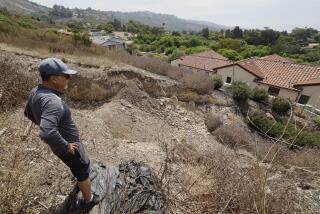Southern California Gas Warns Against PG&E; Plan
As the state Public Utilities Commission today weighs whether to force Southern California Gas to ride to the rescue of Pacific Gas & Electric, the two utilities are spinning dueling doomsday scenarios of a gas-short February.
Cash-strapped PG&E; has taken the extraordinary step of asking the commission to order Southern California Gas to sell emergency supplies. The alternative, PG&E; says, would be to leave its 11 million gas customers in the cold for days and possibly weeks--making the recent threat of electricity outages seem minor by comparison.
Southern California Gas adamantly opposes the plan, citing risks to its own credit-worthiness and the prospect of a gas shortage that inevitably would lead to price increases.
The utilities find themselves in this unusual face-off because natural gas suppliers no longer want to sell to PG&E; and a federal order requiring them to sell to California expires at midnight Tuesday.
If the suppliers make good on their threats to pull out, PG&E; said, it will be forced to begin cutting off large “non-core” industrial customers by mid-February, with residential and small-business customers to follow soon afterward.
Southern California Gas complains that PG&E; would simply be spreading the pain of the electricity crisis to another utility. In fact, the gas company said Tuesday, the mere threat of PG&E;’s proposed solution to its latest problem has caused suppliers and banks to threaten to cut off the access of the Los Angeles-based gas company to natural gas and cash.
“It’s a tough situation. We realize that,” said Edwin Guiles, chairman of Southern California Gas, a subsidiary of San Diego-based Sempra Energy. “But we have got to look out for the interests of our 18 million customers first.”
At the very least, supplying PG&E; would cause prices to rise for Southern California Gas customers, because the utility would deplete its stored gas more quickly and would be forced to turn to the volatile spot market to replenish supplies, Guiles said. But supply shortages could also result, he said.
Guiles vowed to go to federal court to seek an injunction blocking any supply order.
Painting a worst-case picture of gas shut-offs combined with rolling electricity blackouts, PG&E; said public safety would be at risk if it had to interrupt the flow of natural gas to large groups of customers. By that point, PG&E; already would have cut off supplies to the largest users--including gas-fired power plants--and diverted the gas to its core residential and small-business customers.
A break in electric service for an hour or so leaves a homeowner with blinking clocks and warm milk. But turning off the gas would snuff out thousands, maybe millions, of pilot lights, leaving customers with no heat or hot water and no ability to cook with gas. And the sharp drop in pipeline pressure that would precede a mass shut-off would leave the gas lines filled with air, said PG&E; spokeswoman Staci Homrig.
“We would have to go door-to-door and bleed the air out of the lines and relight the pilot lights,” Homrig said. “It would be very labor-intensive. It obviously would be very frustrating to folks.”
PG&E; also has proposed an alternative approach that might spare Southern California Gas at least some of the proposed suffering. If the utilities commission gives its permission, PG&E; would use unpaid customer accounts as collateral to persuade suppliers to keep selling it natural gas.
*
Times staff writer Tim Reiterman contributed to this story.
More to Read
Inside the business of entertainment
The Wide Shot brings you news, analysis and insights on everything from streaming wars to production — and what it all means for the future.
You may occasionally receive promotional content from the Los Angeles Times.










